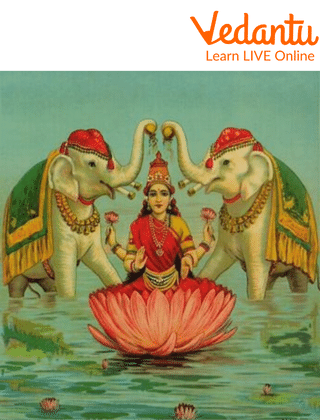Goddess Lakshmi Story in English for Kids

Here, children will get to know a detailed story written about the goddess lakshmi in the religion of hinduism.
They will know how Lakshmi was brought to life.
The positive signs and symbols that goddess Lakshmi signifies.
The various clothes and auspicious times of the month where she is worshipped and respected.
Introduction to Goddess Lakshmi Story
Would you like to introduce the world of Hindu mythology and religion to your child? If yes, starting off with goddess lakshmi is a good choice. In this article, necessary information and details will be provided in a language that can be easily understood by young children, including the story of goddess lakshmi and goddess lakshmi birth story. Children will learn how the goddess was brought to life, what she stands for and how important she is to the Hindu religion and mythology.
Goddess Lakshmi Story in English
In Hinduism, goddess Lakshmi symbolises wealth, prosperity, fertility and of course, beauty. Her name Lakshmi is taken from the Sanskrit word “Lakshya”, which means “aim”.
She is an extremely beautiful woman and is dressed in golden and red robes, with golden coloured skin and four hands, with the upper two holding one lotus each and the lower two showering coins or flower petals as blessings to her worshippers.
The four hands of goddess Laskshmi stand for the goals of human life or humanity, which is righteousness (dharma), desire (kama), wealth (artha) and liberation (moksha), where a soul is free from the continuous cycle of birth, death and rebirth.
She symbolises an independent woman, good luck and fortune, prosperity, beauty and intelligence and is often painted or shown sitting or standing on a huge, beautiful lotus flower.
The lotus signifies beauty, purity, fertility and love. Some paintings and statues show two elephants on each side of goddess Lakshmi spraying water, which in turn means continuous effort that go hand in hand with one’s dharma and artha, leading to moksha.
Most paintings and depictions have an owl either next to her feet or on her shoulders, as that is the vehicle of goddess lakshmi. This nocturnal bird, though not worshipped as such, is also considered as a sign of good luck in Hinduism.
She is also called as “Lokamata”, which means “mother of the world” and “Lola”, as she is well known for blessing people with huge amounts of wealth, goodness, fortune, luck, prosperity and beauty.
She is highly worshipped and respected on full moon nights during Durga Puja and Dussehra and is also the primary focus on Diwali, the festival of lights.
For Hindus, the time of lighting the lamp and prayers take place between 5.00 P.M and 7.00 P.M. During this time, it is said that goddess Lakshmi will visit each house and hence one must not eat, sleep or laze around during this period.
She is the female representation of Lord Vishnu and is also named “Shri” or “Sri” or “Shree”, which is the female energy or material of the highest spiritual power available, such as Lord Brahma, Lord Shiva and Lord Vishnu.
Back in the days, she was highly respected and worshipped in the Indian society as a symbol of continuous good luck, fortune and wealth and still is, even today.

Goddess Lakshmi Standing on a Lotus Holding Two Lotuses and Showering Flower Petals with Two Elephants on Each of her Sides
Goddess Lakshmi Birth Story Moral
In the Indian epic the Mahabaratha, goddess Lakshmi was born from the mixing of the ocean of milk during the war between the gods and the demons. Just when Lord Brahma and Lord Vishnu were going to interrupt the war, she appeared out of the sea of milk (in other versions of the story it is described as a sea of butter too) wearing white clothes and being a perfect representation of beauty, peace and youth. As a result, she is also named as “Ksirabdhitanaya'', which means “daughter of the sea of milk.” She is known to have given up her body, soul and heart to Lord Vishnu, allowing him to be in charge of the full protection of her. Ever since then she is constantly found on the chest of Lord Vishnu, earning him the name “Srinivasa '', which is the “dwelling place of Sri '', which in turn is goddess Lakshmi. She is the Hindu equal of Aphrodite, the Greek goddess of love who was also born from the seas of foam.
Note to Parents
Parents can introduce the life and figure of goddess Lakshmi through the form of story-telling. They can make it twice as interesting and explain the vehicle of goddess lakshmi and the goddess lakshmi birth story which will in turn expose them to the world of the Hindu religion and mythology and can also expand their overall knowledge about Indian gods and goddesses. Knowing this will in turn increase their curiosity about Hinduism and encourage them to read more books about this topic while also developing the habit of reading during the process.


FAQs on Goddess Lakshmi Story in English for Kids
1. Who is goddess Lakshmi’s husband?
In Hindu mythology, goddess Lakshmi is the wife of Lord Vishnu, the god of arts, meditation and the preserver of the universe.
2. What are the other versions of goddess Lakshmi?
Just like how Lord Vishnu has nine reincarnations, Lakshmi too has many reincarnations, with the most famous ones being Sita, wife of lord Ram and Rukmini, wife of Krishna.
3. Who is goddess Lakshmi’s son?
Goddess Lakshmi and her husband Lord Vishnu have a son Kama, which means desire.
Here, children will get to know a detailed story written about the goddess lakshmi in the religion of hinduism.
They will know how Lakshmi was brought to life.
The positive signs and symbols that goddess Lakshmi signifies.
The various clothes and auspicious times of the month where she is worshipped and respected.




